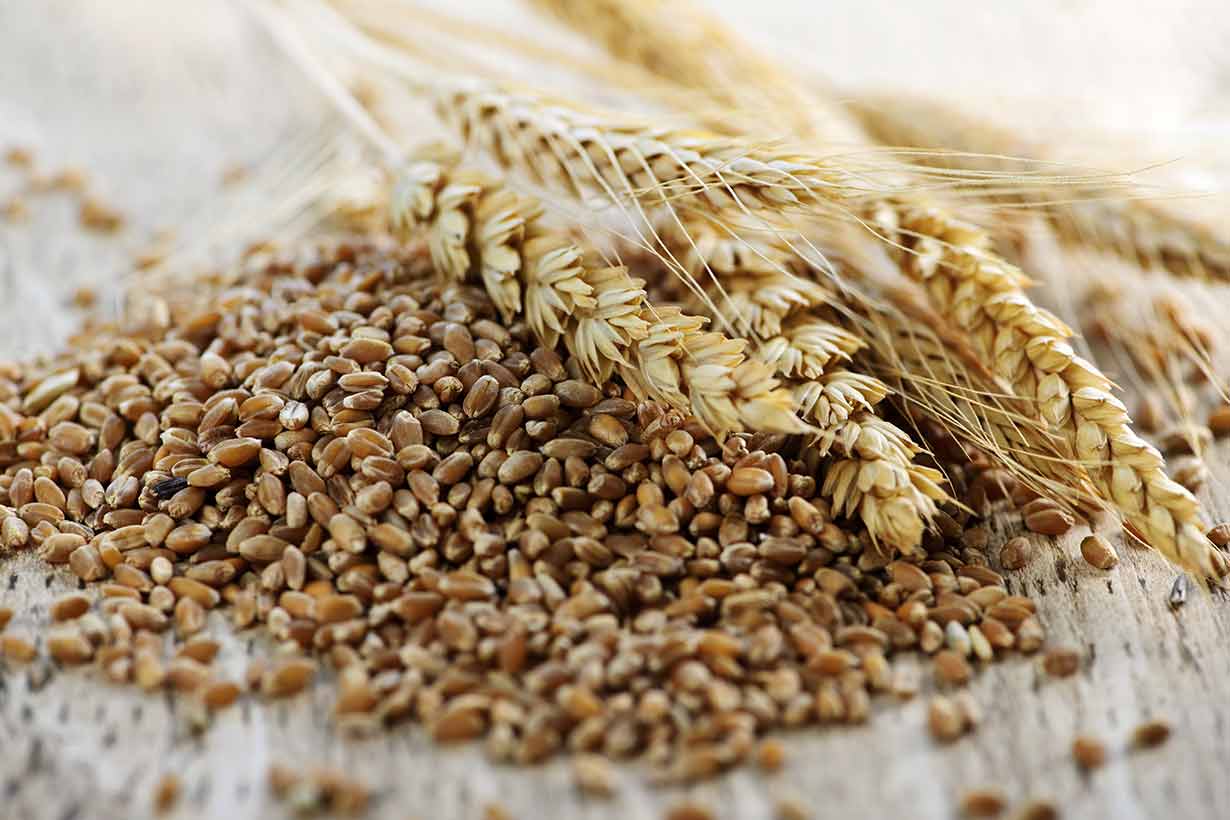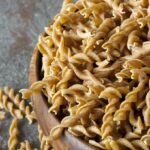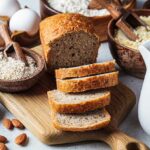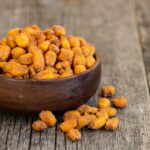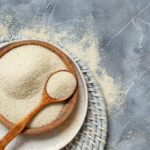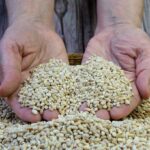People usually imagine the sweet and oilyy popcorn from movie theaters when they think of popcorn.
However, popcorn can be reasonably nutritious, and in its unprocessed state, it is a whole grain.
This article looks at the nutritional properties of popcorn, the different types, and its potential benefits and downsides.
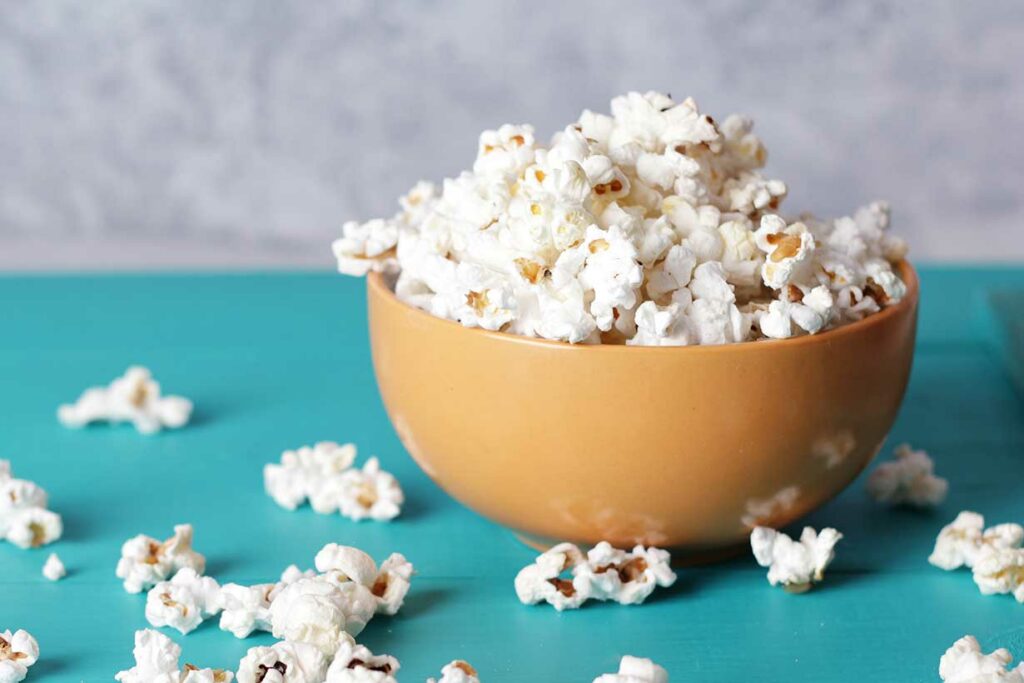
Table of contents
What Is Popcorn?
Popcorn refers to the popped whole-grain kernels that grow on a variety of maize (also known as corn).
The plant that produces popcorn has the scientific name of Zea mays var. everta. For those unaware, this plant is different from other plants in the maize family that produce dent corn, sweet corn, and waxy corn (1).
When raw popcorn kernels are heated, they suddenly burst (or “pop”) and become many multiples larger in size.
The image below shows popcorn kernels before and after popping:
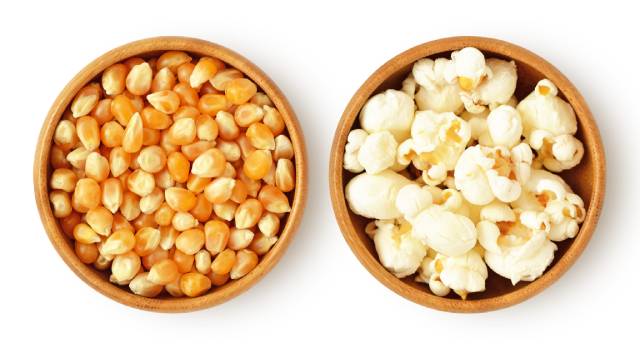
For those interested in why popcorn pops, there is a small amount of water content in the inner layers. The moisture generated from the water presses against the starchy walls until it explodes outward as the popcorn heats up. In other words, the popcorn turns inside out (2).
According to research, popcorn first became part of human diets almost 7000 years ago in South America (3).
In more recent times, popcorn exploded in popularity in the United States during the Great Depression due to its low expense (4).
Interestingly, popcorn used to be used as a popular breakfast cereal (served with milk) in the United States (5).
At present, it is mainly a snack that people enjoy while watching movies or sports events. Generally speaking, popcorn is popped by air or in oil, and there are some key differences between the two.
What is the Best Type of Popcorn?
The main two types of popcorn are air-popped and oil-popped.
There will be clear nutritional differences between them:
- Oil-popping will increase the calorie and fat content of the popcorn.
- By weight, it will also slightly decrease the carbohydrate, fiber, protein, and vitamin and mineral content.
Aside from homemade popcorn, buying ready popped store-bought varieties is also possible.
However, many packaged popcorn products contain large amounts of added sugar, salt, and oils, thus decreasing their nutritional value.
As a result, the most nutrient-rich form of popcorn is regular, air-popped popcorn.
Air-popped popcorn tends to be a reasonably good source of protein and provides a significant fiber source (6).
Nutrition Facts
Using data from the USDA’s FoodData Central database, below you can see the nutritional values for air-popped popcorn per 100 grams. All daily values have been calculated using the USDA data and the FDA’s published daily values (6, 7).
| Name | Amount | % Daily Value (% DV) |
|---|---|---|
| Calories | 385 kcal | |
| Carbohydrate | 77.5 g | 28% |
| Fiber | 14.4 g | 51% |
| Sugars | 0.87 g | |
| Fat | 4.52 g | 6% |
| Saturated Fat | 0.63 g | 3% |
| Monounsaturated Fat | 0.95 g | |
| Polyunsaturated Fat | 2.31 g | |
| Omega-3 | 0.05 g | |
| Omega-6 | 2.25 g | |
| Protein | 12.9 g | 26% |
Vitamins
- Niacin (B3): 14% of the daily value
- Pantothenic acid (B5): 10% DV
- Vitamin B6: 9% DV
- Thiamin (B1): 9% DV
- Riboflavin (B2): 6% DV
- Folate: 8% DV
- Choline: 4% DV
- Vitamin A RAE*: 1% DV
- Vitamin K: 1% DV
*RAE = retinol activity equivalents.
As we can see from these vitamin values, popcorn provides a moderate source of B vitamins.
Minerals
- Magnesium: 34% DV
- Phosphorus: 29% DV
- Copper: 29% DV
- Zinc: 28% DV
- Iron: 18% DV
- Potassium: 7% DV
- Sodium: 7% DV
- Calcium: 1% DV
- Sodium: <1% DV
Popcorn provides significant levels of magnesium, phosphorus, copper, zinc, and iron.
Does Popcorn Have Any Benefits?
Popcorn may provide some benefits due to its nutritional and non-nutritive components.
Here is a summary of these potential benefits.
High In Fiber and Protein
Popcorn is high in fiber and protein, containing 14.4 grams and 12.9 grams, respectively, per 100 grams (6).
Both protein and fiber are thought to help enhance satiety, which refers to the feeling of fullness with no further desire to eat after a meal (7, 8).
Each also has its unique benefits, with protein being vital for growth and repair, building/maintaining lean body mass, and bone health (9).
Regarding fiber, higher intakes are also quite consistently associated with reduced cardiovascular and all-cause mortality (10).
Further, higher fiber intakes appear to correspond with a more health-supportive gut microbiome (11).
For more high-fiber and protein grains, see these barley and wheat germ guides.
Popcorn is a “Healthier” Snack Option and May Help With Satiety
If an individual is already eating enough food each day, adding popcorn to the diet isn’t going to help.
However, it can be a healthier snack option than other typical snack foods such as potato chips and other corn-based snacks like corn nuts.
Little steps rather than giant leaps are often the best way to improve our way of eating; substituting popcorn for potato chips is one such little step.
It has been studied too. For example, a 2012 human trial on satiety examined how popcorn compared to potato chips for short-term satiety impact and subsequent energy intake (12).
Interestingly, in thirty-five healthy adults, consuming six cups of popcorn (100 calories) led to greater satiety and lower energy intake at the next meal than one cup (150 calories) of potato chips.
Since popcorn is so light, it is easy to eat a significant volume of it for very few calories, which the above study suggests may help with appetite.
Gluten-Free
Like other grains such as buckwheat, fonio, and rice, all varieties of corn (including popcorn) are gluten-free.
This means that popcorn is suitable for people following gluten-free diets.
Popcorn Is a Rich Source of Polyphenols
Sometimes referred to as “antioxidants,” polyphenols are chemical compounds found in plant foods, and they are associated with health benefits (13, 14, 15).
Based on nine popcorn samples, the contents were 5.95 mg of polyphenols per gram on average. This is equivalent to 595 mg (or 0.59 grams) per 100 grams (16).
Surprisingly, the polyphenol content of popcorn compares favorably to the amounts in berries, which range from around 100 mg to 500 mg per 100 grams (17).
It is worth pointing out that despite the associations with health benefits, it is difficult to make definitive claims about the health effects of polyphenols.
One reason for this is that polyphenols have low bioavailability, and they are quickly metabolized. This makes it challenging to test for benefits in human trials (18).
However, it is currently thought that they are at least partly responsible for the benefits seen by higher intakes of fruit and vegetables. Nevertheless, more research is necessary to understand this topic better (19).
Does Popcorn Have Any Downsides?
Outside of uncommon corn allergies, there are no real downsides about popcorn other than the processing it sometimes undergoes.
As previously mentioned, many pre-packaged popcorn and movie theater popcorn products contain large amounts of added fat, salt, and sometimes sugary toppings.
The table below, using USDA data, shows just how much this processing can change the nutritional value of popcorn per 100 grams (6, 20, 21):
| Name | Air-popped Popcorn | Movie Theater Popcorn | Sweetened Oil-Popped Popcorn |
|---|---|---|---|
| Calories | 385 kcal | 656 kcal | 464 kcal |
| Carbohydrate | 77.5 g | 31.6 g | 67.9 g |
| Sugars | 0.87 g | 0.29 g | 28.6 g |
| Fiber | 14.4 g | 5.4 g | 7.1 g |
| Fat | 4.52 g | 58.8 g | 17.9 g |
| Saturated | 0.63 g | 35.5 g | 3.57 g |
| Monounsaturated | 0.95 g | 11.7 g | Not listed |
| Polyunsaturated | 2.31 g | 8.45 g | Not listed |
| Protein | 12.9 g | 4.96 g | 7.14 g |
| Sodium | 162 mg | 756 mg | 643 mg |
As we can see from the data in the table, air-popped popcorn is the healthiest choice of popcorn.
Movie theater popcorn contains significant amounts of calories, saturated fat, and approximately one-third of the recommended daily sodium intake (22).
Packaged and sweetened popcorn also contains large amounts of sugar, similarly high sodium content, and more calories.
Also, these more processed varieties of popcorn contain far lower amounts of fiber and protein than plain air-popped popcorn.
How To Improve the Taste of Air-Popped Popcorn
There is one argument for more processed varieties of popcorn: they have more flavor due to all the additional ingredients.
However, it is relatively easy to flavor air-popped popcorn, and various seasonings work well.
Some of these include:
- Cayenne pepper
- Cheese powder
- Cinammon
- Cocoa powder
- Curry powder
- Garlic powder
- Hot chocolate powder
- Italian seasoning
- Nutmeg
- Nutritional yeast
- Smoked paprika
Depending on personal preference, a small amount of sugar or salt may also help the popcorn taste better.
Time needed: 1 minute
Just follow these easy steps to make seasoned air-popped popcorn:
- Put the popcorn in a bag
Add the air-popped popcorn while it is still hot.
- Add seasoning
Sprinkle some of the preferred seasonings over the top of the popcorn.
- Shake
Seal the bag, and then shake for 15 seconds to ensure the seasoning spreads over the popcorn evenly.
- Serve
Enjoy!
How To Make Air-Popped Popcorn At Home
Popping popcorn kernels at home may sound like a complicated process, but it is surprisingly easy to do.
The easiest way to do it is by using a microwave: first place the whole grain popcorn kernels in a paper bag, then fold and seal the top of the bag.
Then, put the bag in the microwave and turn on the power. You will soon start to hear the popcorn popping, but wait until the process seems to be slowing down, and then remove the bag from the microwave.
After removing, don’t open the bag until the popping finishes. The popcorn should now be ready!
Final Thoughts
Nutritionally, popcorn provides a good mixture of fiber, protein, B vitamins, several minerals, and polyphenols.
On the downside, packaged popcorn and popcorn sold at retail typically have a less-than-desirable nutrition profile, and they often contain excessive amounts of fat and salt.
All in all, popcorn can be a nutritious food when prepared in the right way. It can also be interesting to try different home-blended seasonings for various flavor experiences.
Alongside products such as whole wheat pasta, popcorn is also one of the easiest ways to consume more whole grains.

